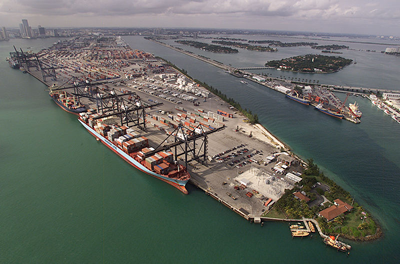
Senator Boxer’s Floor Statement on the Water Resources Reform and Development Act of 2014 (WRRDA)
(Remarks as prepared for delivery)
I am so pleased that the bipartisan conference agreement on the Water Resources Reform and Development Act of 2014 (WRRDA) is before the Senate today following yesterday’s overwhelming and bipartisan approval in the House of Representatives by a vote of 412-4. This is a bill that rises above partisan politics. I am glad that we will consider it expeditiously so we can quickly send it to the President for signature.
Let me tell you why this bill is important to the American people and to our economy. And why it is essential that we pass this bill into law.
The conference agreement makes important investments and reforms related to our nation’s ports and waterways, which moved over 2.3 billion tons of goods in 2012.
The bill will allow construction of vital port projects across the country. These include a project in Texas to widen and deepen the Sabine – Neches waterway, which will have over $115 million in annual benefits. This critical waterway transports over 100,000 tons of goods every year, is the nation’s top port for movement of commercial military goods, and is vital to the nation’s energy security.
The bill will allow the Corps to address dangerous cross currents at the Port of Jacksonville, Florida, that create safety concerns for ships entering and exiting this port. It also authorizes the deepening of this vital hub of commerce.
The bill also authorizes a project to deepen the Boston Harbor to 50 feet. This will prevent heavier road traffic in the busy Northeastern corridor by allowing the larger vessels coming through the newly deepened Panama Canal to transport cargo all the way north to Boston Harbor. Without the access to Boston, these vessels would have to offload in other ports and put the cargo on trucks to their final destinations in the Northeast.
In addition to authorizing crucial port projects, the bill reforms the Harbor Maintenance Trust Fund to increase port investment. Despite significant maintenance needs at our nation’s ports, only roughly half of the taxes collected in the Harbor Maintenance Trust Fund each year are actually used for port maintenance activities. This conference report calls for full expenditure of all revenues collected in the Trust Fund by 2025. This will improve the flow of commerce at the approximately 360 ports around the country.

We set priorities that make sense for the larger ports, the smaller ports, the Great Lakes, and the sea ports that are large donors to the fund, such as the Ports of Los Angeles and Long Beach.
The conference report also makes important reforms to the nation’s inland waterways system, which is essential for transporting goods throughout the country. These include efforts to expedite project delivery and better prepare for future floods and droughts that can slow or even stop navigation on the inland waterways.
The conference report authorizes much-needed flood control and coastal hurricane protection projects across the country. I will give a few examples, starting within my home state of California.
Sacramento faces some of the nation’s most severe flood risk. This bill contains flood protection measures that will allow the Corps of Engineers to strengthen the levees in the Natomas basin in Sacramento, which safeguard approximately 100,000 Californians and protect over $8 billion in property.
The bill also provides life-saving flood protection for more than 200,000 residents of Fargo, North Dakota and Moorhead, Minnesota.
The bill will restore the reliability of the levee system that protects Topeka, Kansas. These levees protect thousands of homes and businesses in the city. And this project will return over $13 dollars in benefits for every dollar invested.
And the bill will provide life-saving hurricane protection for communities in coastal Louisiana.
In addition, the conference report will improve our responses to extreme weather events. After the devastation caused by Hurricane Katrina and Superstorm Sandy, it became clear that communities need assistance to protect lives and property and improve infrastructure resiliency from the impacts of extreme weather and natural disasters.
For the first time, this bill allows the Corps to conduct immediate assessments of affected watersheds following an extreme weather event. The Corps will be able to identify and construct small flood control and ecosystem restoration projects, such as building levees and flood walls, and restoring wetlands, without going through the full study process and receiving additional Congressional authorization.
The conference report calls for the Corps to use resilient construction techniques that are more durable and sustainable in the face of extreme weather and requires the National Academy of Sciences and Government Accountability Office to evaluate options for reducing risk from extreme weather events.
The bill authorizes investment in vital ecosystem restoration projects around the country. These projects not only preserve our precious natural heritage but also provide essential benefits to local communities, such as improved flood protection and a boost to local tourism.
WRRDA continues the commitment to restoring one of the nation’s greatest environmental treasures – the Florida Everglades – by allowing four new Everglades restoration projects to move forward. We also reauthorize important restoration programs in the Chesapeake Bay and Colombia River Basin, enable the Corps to work with States along the North Atlantic coast to restore vital coastal habitats from Virginia to Maine, and allow the Corps to implement projects to better prepare for extreme weather in the Northern Rocky Mountain states of Montana and Idaho.
We direct the Corps to give priority to ecosystem restoration projects that will also provide benefits for public health. This ensures projects like the restoration of the Salton Sea, which both restores vital habitat and addresses serious air quality concerns, can move forward.
The conference report also addresses important ocean and coastal resiliency issues, allowing the Corps to carry out ocean and coastal resiliency projects in coordination with a broad range of stakeholders, including states, federal agencies, and NGOs.
We also have a new initiative to assist localities in need of loans for flood control or wastewater and drinking water infrastructure to receive those loans from a new funding mechanism we have named WIFIA, the Water Infrastructure Finance and Innovation Act.
WIFIA will allow localities an opportunity to move forward with water infrastructure projects in the same way that TIFIA works in the transportation sector. Where there is a local source of funding to reimburse the federal government, the federal government can front the funds in order to speed up the process.
These funding arrangements supplement existing programs and will help to leverage more investment in our nation’s aging infrastructure. The conference report also updates the Clean Water State Revolving Fund to ensure that our existing sources of water infrastructure funding are able to continue to meet pressing infrastructure needs.
The conference report authorizes 34 critical Army Corps projects where the Chief of Engineers has completed a comprehensive study. These projects will strengthen infrastructure that protects lives and property, restore vital ecosystems to preserve our natural heritage, and maintain navigation routes for commerce and the movement of goods.
For the future, we have also developed a system that allows local sponsors to make their case directly to the Corps and for the Corps to recommend projects to Congress for authorization.
Just over one year ago, the Senate passed the Boxer-Vitter WRDA bill by a vote of 83-14. The House followed suit last fall by passing its own bill. After six long months of work, the conference committee has produced an agreement that has already passed the House by an overwhelming margin. This agreement will cost roughly the same as the Senate-passed bill and well below the last WRDA bill that was passed in 2007.
Before I close, I would like to thank all of the staff on both sides of the aisle that have put in countless hours to develop this bipartisan, bicameral agreement. I would like to thank Bettina Poirier, Jason Albritton, Ted Illston, and Tyler Rushforth on my staff and Zak Baig, Charles Brittingham, and Chris Tomassi on Sen. Vitter’s staff.
It is now time for the Senate to show the American people that we can come together and pass this bill, which has the support of a broad and diverse group of stakeholders, including the AFL-CIO, the Chamber of Commerce, the National Association of Manufacturers, the Nature Conservancy, the Farm Bureau, and the American Association of Port Authorities.
This is just a small fraction of all of the support letters we have received. I ask unanimous consent to enter a list of all of the supporters of the conference report into the record.
The last WRDA bill became law in 2007, and it is past time for a new authorization bill to invest in the nation’s water infrastructure. I urge all my colleagues to support this important legislation.












